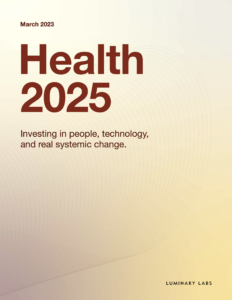Eight leaders explain why they’re prioritizing people, technology, and real systemic change.
In many ways, 2022 felt like a transitional year for healthcare. But it’s difficult to define exactly what that transition is.
The coronavirus pandemic continues but, for many, it feels like less of an emergency than like a new way of life. Pandemic darlings, including telehealth, have demonstrated what’s possible, but have not achieved the scale expected. Pharma has narrowed its interest in digital therapeutics (DTx) to continue its efforts, but under new aims. Investments in artificial intelligence and interoperability are necessary line items, but they no longer make headlines. Value-based care is, well, hard.
The desire for optionality is stronger than ever: We want telehealth visits, and we want to see our doctors in person. We want to work from home, and we also want to connect with colleagues. We want apps that track meaningful health data, and we want expert humans to advise us.
For health industry leaders, it’s a confusing time to be in charge. With all of the possible investments to make, what should executives prioritize so their organizations come out on top in the next year or two?

The Health 2025 report features our analysis of survey responses. Download the full report to find out how executives are prioritizing investments in people, technology, and real systemic change.
To find the answer, Luminary Labs invited healthcare executives to participate in a simple survey focused on just one question: “What’s the one thing every healthcare leader should invest in next year (2023) to prepare for 2025?”
The survey, which was open from November 13, 2022, through January 12, 2023, received 101 responses from a total of 77 organizations — including pharma and biotech, health IT and technology, providers, startups, investors, professional services and payers. Nearly half of respondents are in roles at the VP or executive director level; over one-third represent C-suite roles; and the remainder represent mid-senior or director roles.
Before we even concluded the formal analysis, we were struck by the sentiment surrounding an investment in humans: The number of responses that mention the words people, patients and talent outnumber responses that mention words such as technology, digital and data. Shiny objects are few and far between; when respondents mention specific technologies, they often reference investments in the infrastructure and systems required to create real value.
Could this be the end of shiny object syndrome?
To be sure, early experimentation is prerequisite to innovation: The pacemaker would not have been possible without hypothermia research, and health wearables would not have been possible without someone asking what smaller and lower-cost sensors could do. But real leadership is knowing when to shift from investing in innovations in search of problems to starting with a problem and translating innovation to achieve an ideal end state. In a more mature industry, people are fixing things that are broken. Digital health innovation is moving out of the garage and taking its rightful place inside the system, focusing on the underpinnings that make real transformation possible.
To that end, we’ve identified five themes from survey responses — all focused on prioritizing investments in people and systems to make healthcare more efficient and effective.
Workforce, leadership and skills
In every industry, employers have had to rethink their relationships with employees. And due to changing demographics and cultural norms, many recent shifts are likely to stick. Almost 14% of survey responses mention the word talent, and 10% mention the word team. A number of responses also mention culture, management and leadership.
“Despite our industry’s deep roots in a strong purpose to improve people’s lives, healthcare has hardly been immune to the great resignation, making recruiting and retention key for the next several years,” says Stacy Feld, regional head, Johnson & Johnson Innovation, West North America, Australia and New Zealand. Feld advises life sciences companies to invest in talent management strategies that both retain and attract new talent, adding, “This includes designing personalized career pathing opportunities for development and growth, showcasing the impact of their team’s role in delivering meaningful work, building an inclusive culture and community in the workplace and being open to external and company alumni talent.”
While no industry has been untouched by uncertainty, pharma, payers and providers have historically cultivated talent from within and stuck to traditional models. In recent years, efforts to infuse new thinking by hiring from tech and consumer brands have yielded mixed results — from culture clashes to relatively short tenures. Simply injecting people from outside pharma can’t fix health, but it’s obvious that health won’t be fixed with the current mindset.
Building entirely new values, talent cultures, and leadership models will require bravely breaking from the past, and that means a new era of leadership, says Sachin Jain, president and CEO, SCAN Group & Health Plan. “Healthcare is at the end of a period of magical thinking when we believed that the problems were easier to solve than we thought they were.” Over the past decade, the industry looked to policy, data, startups and big tech — only to realize that those are not enough to solve health’s deepest problems. “It leaves you standing in the mirror, asking, why aren’t things getting better?” says Jain, adding, “The answer is the person on the other side of that mirror.” The investment needs to be in people themselves.
Augmenting humans
Gone are the fears of healthcare workers being replaced by robots. If health tech has a North Star, it is augmenting the humans we have. “The staffing crisis is crushing frontline healthcare, from hospitals to primary care. Leaders need to be thinking about replenishing and nourishing their teams. There needs to be structural changes beyond hourly pay rates that address burnout being felt across the industry, and make caring for patients a sustainable career for those who choose it,” says Catherine Olexa-Meadors, SVP, innovation and partnerships of Aledade.
While the pandemic has contributed heavily to awareness of talent shortages, the graying of America has hit healthcare on both ends of the equation. Not only do we need to figure out how to care for an increasing number of older adults, but we will also need to do so with fewer workers — and this is not changing anytime soon. According to the U.S. Census Bureau’s projections, by 2035 there will be more people over 65 than under 18.
The healthcare industry can’t change demographic trends, but organizations can provide frontline workers with technology that makes work more efficient, effective and fulfilling. A number of survey respondents recommend investing in tools and processes — including documentation and support for clinical decision-making — to ease the burden of the current labor shortage.
The challenge, of course, is knowing which tasks should be automated and which require the human touch. Chris Hogg, cofounder and CEO of Marley Medical, advises companies to first invest in understanding manual interactions, then invest in determining which should be automated. The goal is “risk stratification — not everyone should be treated the same,” says Hogg. He describes a scenario in which a patient with a device is seen three times a year. For some people, a low level of interaction works, but others require more human touch. “Don’t invest in shiny tech objects, but in real tools that make clinical operations more effective: remote monitoring, messaging, automating routine care pathways, documentation and billing, etc. Use tech to make lives better for care teams, which will also improve outcomes and margins if done correctly,” says Hogg.
Patients
Not surprisingly, many survey responses (nearly 16%) mention the word patient. What is the purpose of health, if not to improve experiences and outcomes for patients? It makes sense that organizations are focused on their customers — but in health, the approach to achieving positive outcomes depends on an organization’s role in the ecosystem.
In an era when far-reaching digital investments have fallen out of favor in pharma, diagnosis, adherence and loyalty are the big things to get right. And when those priorities are rooted in an understanding of the patient experience — from diagnosis and care access to treatment and management — these investments both improve patient outcome and become differentiators.
For those closer to the delivery of healthcare, an investment in the workforce is also an investment in patient outcome. For Olexa-Meadors, “the risk is simple, but important: If we don’t invest in frontline talent, patients will not get the care they need.” A number of respondents shared that improving clinical decision making is good for the provider — and great for the patient.
Employers are increasingly aware that all employees are patients. “Leaders need to understand the mental health challenges that individuals are facing today and invest in mental health services to better meet the needs of those they serve,” says Cara McNulty, president, behavioral health and mental well-being at CVS Health. “This means moving from traditional employee assistance program (EAP) efforts to services that address the mental, physical and social determinants of all communities.” McNulty cites a combination of both digital and traditional services to meet people where they are.
Bridging the physical and digital worlds
McNulty is not alone in seeking to create connections between physical and digital health interactions. “Lots of solutions focus on tech or digital; lots on brick and mortar or the physical aspects of care. Too few have yet cracked the code on uniting them to create new impact and value. This is what people actually need more of,” says Unity Stoakes, cofounder and president of Startup Health.
Several respondents, including John Brownstein, chief innovation officer at Boston Children’s Hospital, recommend investments in home care. Once considered only viable for hospice, home care and hybrid care are increasingly associated with primary care, post-surgical care and remote monitoring. “One key reason is patient preference. Many patients prefer to receive care at home, as it allows them to be in a familiar, comfortable environment and can be more convenient for them,” says Brownstein, who added that “providing care at home can also be more cost-effective than providing care in a hospital or other inpatient setting, which is especially important as healthcare organizations face pressure to reduce costs and improve efficiency.” The clincher? Brownstein notes that investments that support contextualized, personalized and coordinated care may have better health outcomes.
Inside and outside of health, pandemic-era adaptations have shown the value of technologies that enable remote and virtual experiences. From home care to decentralized trials, there’s a desire to use technology in a way that improves health outside of clinical settings.
When it comes to connecting the digital and physical, it’s worth noting that the technology currently exists. What leaders need to do now is think systematically about bringing it all together. Stoakes points to pandemic innovations, such as the development of mRNA, as proof that we can shorten development-to-deployment time in other areas. “If we think about where we are today with the AI revolution coming to our culture in ways that will transform lives in practical ways, it’s one of the most exciting times in history in terms of innovation and change. What hasn’t changed, though, is the need to more seamlessly bridge the digital and physical worlds. There is a tremendous opportunity for new platforms to emerge that make it easy to bring new innovative digital solutions and make them more relatable, relevant, and useful in our everyday lives,” says Stoakes.
Infrastructure
To have real-world impact, health innovations must achieve scale. And scale is contingent upon myriad factors, including investments in capabilities that bring people and technology together. “Our earliest health tech experiments flopped as we did not think systematically,” says Hogg. “It’s not just about the product, it’s about the problem, the patients, how we acquire them, how it fits into the continuum of care — and how you get paid for it.”
This systems-level view is shared by a number of respondents who indicate that leaders should invest in the scaffolding required to deliver on the promise of technology. For Dennis Urbaniak, EVP, digital therapeutics at Orexo, this starts with “practical data and analytical capabilities that can be deployed and implemented in the real world. The need and demand to demonstrate actual impact in the market will only increase, and real-world impact is the one area that all stakeholders — payers, patients, providers, policymakers, investors — will align on.”
It takes a village to change a system, and investments in infrastructure often extend beyond a single organization. Several respondents note that investing in cross-functional partnerships can increase adoption and scale. While healthcare has had its share of tumultuous partnerships, going it alone isn’t a viable option when making an ecosystem play.
An engineer would never want to build something without a plumb line or a level; likewise, alignment is critical for building foundational healthcare infrastructure. “The most important ‘infrastructure’ is an aligned, objective process to set a baseline and report on progress against that baseline, which also implies an ability to collect data in that context,” Urbaniak says. “This does not have to be some massive expensive IT and data effort, but more of an agreed measurement approach with arbitration rules defined in advance.”
We have the tools and technologies — now we just need to align our efforts. All signs point to 2023 as a moment when the health industry is ready to focus on what really matters: solving real, systemic problems to improve the lives of real people.


